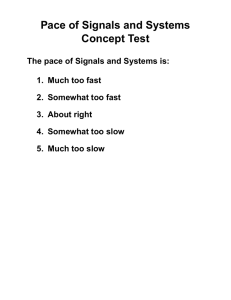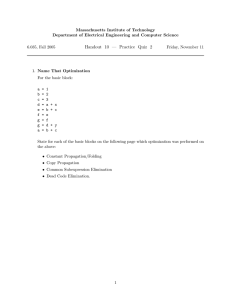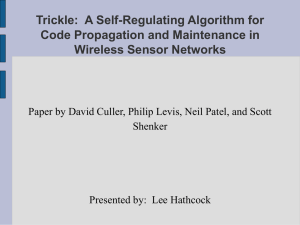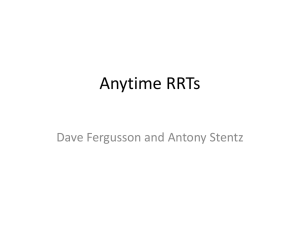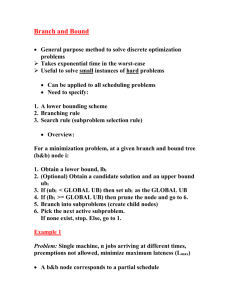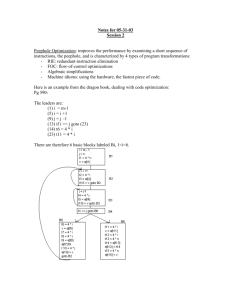Powerpoint Slides
advertisement
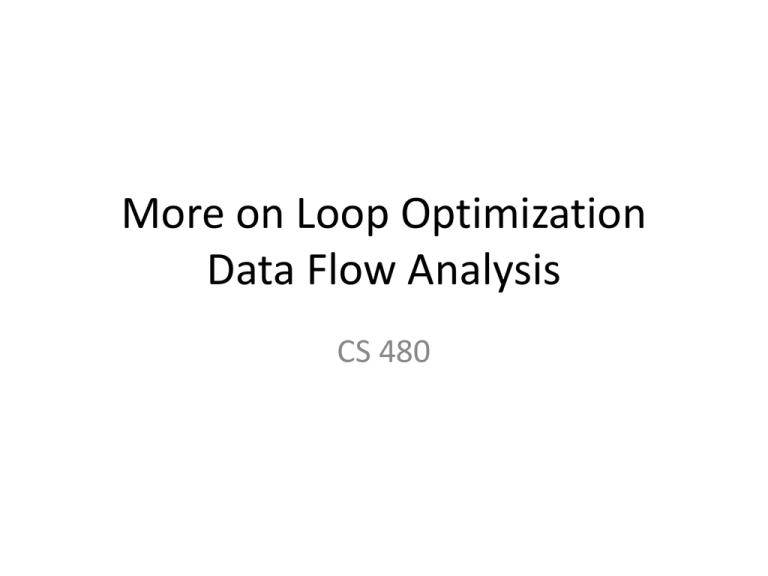
More on Loop Optimization
Data Flow Analysis
CS 480
Make a broader goal for loop
optimization
• General idea:
– Link every assignment of a variable to the set of all
places it might possibly be used
– Link every use of a variable to the set of all places
it might possibly have been assigned
• In general, a use might have several
assignments, and an assign will almost always
have many uses
How to do this
• Fundamental equation
For each node: out = (in – kill) union gen
Out: variables (and values) that flow out of a
node
In: variables (and values) that flow in to a node
Kill: variables killed by a node
Gen : variables (and values) generated by a node
Note that kill definition slightly
different
• For common subscripts kill was defined as
“possibly altered”
• For this we need to define kill as “possibly
survive”
X = 12
*p = 42
…
If (x < b) // could use of x come from assign?
Apply equations repeatedly
• Apply equations to each node in the graph
until nothing changes
• Will certainly need to do this repeated times
x=3
while (x < a) // link use of x to assignment
if (b > 0) x = x + b
else x = x - b
Once we have this information, what
can we do with it?
• What is a variable that is used but never
assigned to?
• What is a variable that is set but never used?
What about this one?
max = 142
…. // lots of code, none of which changes max
If (a < (max – 1)) ….
// called constant propagation
Dead code elimination
• Can possibly discover, at compile time, that a
whole section of code cannot possibly ever be
executed.
• Think that no good programmer would ever
do this?
How many people have done this?
Debug = false
…
…
If (debug) { … }
…
Why generate code that is not executed?
Copy Propagation
• After
X=y
X and y are aliases of each other until one or the
other is reassigned.
Can look for common subexpressions that might
not be obvious
Z = (x + 42) * w
G = (y + 42) * w
From previous lectures
• Loop invariant code (expressions with no set
inside of loop)
• Induction variables and the resulting
reduction in strength
Common subexpressions that span
nodes
• Previously we only looked at common
subexpressions within a single node
• What about expressions that span nodes –
called available expressions
A[x + 42] = 17 // subscript is common
If (b < 39)
a [ x + 42 ] = 18 // can be saved and reused
Or can be distributed out
• Or, common subexpressions can be moved
back to a previous common node – called busy
expressions
if (a < 12)
b[x + 32] = 17
Else
b[x + 32] = 49 // can move subscript before if
Live-dead analysis
• When registers are used to hold variables
(more next week) need to know when a
variable is no longer being used, and can free
up the register
• Called “live-dead analysis”
New one – polymorphism elimination
Var w : window
….
W = new textWindow();
….
w.draw(); // if we can ensure that w is a
textwindow can probably generate faster code
Bottom line
• Data flow analysis, matching every variable set
and every variable use, is one of the most
powerful tools in the optimizer writers set of
tricks
